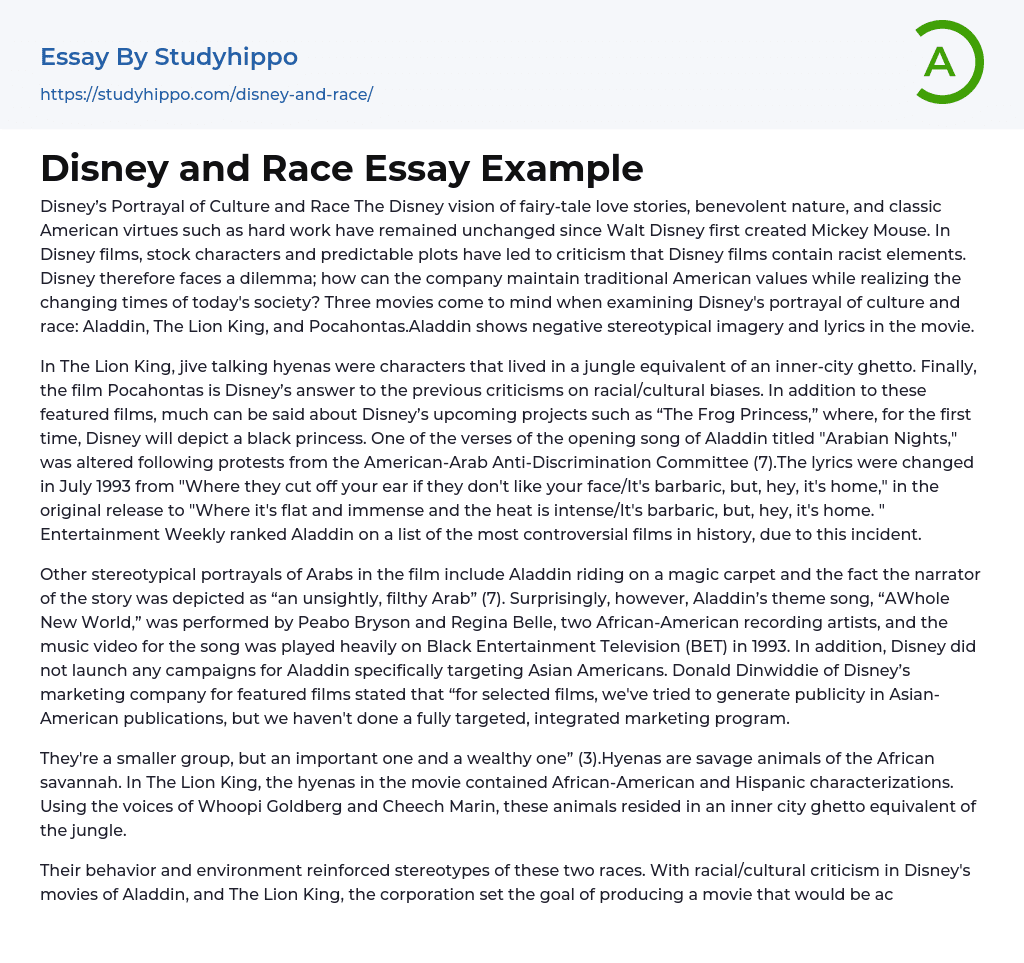Disney has maintained its vision of fairy-tale romances, the goodness of nature, and traditional American values such as hard work, since the creation of Mickey Mouse by Walt Disney. However, Disney movies have been criticized for containing racist elements due to stereotypical characters and predictable storylines. Disney faces the challenge of balancing its traditional values with changing societal norms. The portrayal of culture and race in Aladdin, The Lion King, and Pocahontas highlights this challenge. Aladdin specifically contains negative stereotypes in both the visual imagery and lyrics.
The Jungle portrayed in The Lion King featured jive-talking hyenas, creating an urban jungle equivalent to a ghetto. Pocahontas, a Disney film, aimed to address criticisms of racial and cultural bias. "The Frog Princess," Disney's upcoming project, will mark their first depiction of a black princess. Aladdin's opening song "Arabian Nights" faced pro
...tests from the American-Arab Anti-Discrimination Committee for one verse that was altered in July 1993 due to its offensive nature. Entertainment Weekly added Aladdin to their list of controversial films after this incident.
The film Aladdin perpetuates common representations of Arabs, including a magic carpet ride and portraying the narrator as an offensive Arab stereotype. Surprisingly, the theme song for the film, "A Whole New World," was sung by African-American artists Peabo Bryson and Regina Belle. Furthermore, the music video for the song was highly promoted on Black Entertainment Television in 1993. Despite this, Disney did not launch any advertising campaigns targeting Asian Americans for Aladdin. Donald Dinwiddie from Disney's marketing company confirmed that while they did promote selected films in Asian-American publications, they did not execute a fully integrated marketing strategy for Aladdin.
According to (3), hyena
are a significant and affluent minority in the African savannah. In the movie The Lion King, the portrayal of hyenas included traits associated with African American and Hispanic culture, and these characters were voiced by Whoopi Goldberg and Cheech Marin. Furthermore, in the film, the hyenas inhabited an urban-like jungle setting that resembled a ghetto.
Disney's previous films, Aladdin and The Lion King, perpetuated racial stereotypes. However, the corporation strove to produce a movie that would be universally accepted and fair towards all cultures with Pocahontas. This film tells the story of a love affair between an English captain and a young Native American woman. In order to ensure cultural accuracy and sensitivity, Disney underwent three years of sensitivity training during production. They consulted with descendants of Powhatan Indians, academics, historians, and leaders from American Indian organizations in order to avoid any biases or unfair representation of Native Americans. (3)(5)
While creating the film Pocahontas, the filmmakers - including writers, directors, animators, and composers - traveled to Jamestown, Virginia where they found inspiration from the original colony (5). Co-director Eric Goldberg discussed the difficulty of accurately portraying culture in a sensitive manner and emphasized how crucial visual details are for accurately depicting cultural elements. He expressed optimism that Disney could improve this aspect by hiring diverse casts and advisers (5).
Disney products and ideologies are directed towards the white middle class, indicating cultural bias. Michael Rooney, a past employee of Disney's publishing company "Discover," disclosed that their magazines are aimed at families and children aged around 35 with a specific income range, primarily baby boomers and their offspring (8). Having studied 13 Disney commercials broadcasted from 1971 to
2007, it was evident that the first commercial to feature a person of color was in 1987; however, they were presented as employees and not park visitors.
While earlier commercials favored white characters, recent ads have started to highlight people of color, specifically African Americans. In 1993, the first commercial with an African American father and son appeared briefly; it took until 2002 for a full-length ad featuring a person of color to be produced. Despite this progress, Asian and Latino communities remain underrepresented in advertising. Dinwiddie notes that approximately 70% of African Americans over the age of 12 watch at least one movie per month, while Hispanic audiences attend animated films at higher rates than the general population.
According to source (3), Hispanic families often prefer group or family unit photos making them appealing. Conversely, images in media featuring white characters, including animations, perpetuate the notion that whiteness is usual and conventional. Source (5) describes how Disney's portrayal of female cartoon protagonists undergoes "orientalization" as European or male individuals "distance" and "exoticize" minority groups to construct themselves as objective, rational, and civilized. This can be observed in films like The Little Mermaid, Beauty and the Beast, Aladdin, Pocahontas, and The Hunchback of Notre Dame through both the physical appearance and iconography of characters. The depiction of Disney's heroines experiences a transformation from youthfulness to sexuality as they mature, with particular focus on physical traits. For instance, Pocahontas' torn clothing and dark skin appear almost Amazonian while Esmeralda from The Hunchback of Notre Dame is portrayed as voluptuous.
Walt Disney Feature Animation is creating The Frog Princess, an animated movie set in New Orleans during the 1920s Jazz
Age. It will be a musical and introduce Maddy, the first black Disney Princess. The release date for the film is scheduled for 2009. Maddy will join eight other Disney princesses who have generated $3 billion in retail sales worldwide since 1999. The Disney Princess brand is currently Disney's fastest-growing consumer products division.
The Disney Princess roster comprises Jasmine, Pocahontas, Cinderella, Belle, Snow White, Beauty, Ariel, and Mulan. There has been a lot of buzz surrounding the idea that introducing a Black Princess could open up fresh potentialities for Disney's Princess-related products marketing. Disney puts in considerable effort to foster cultural diversity across its films and merchandise. Despite trying to appeal to a wide-ranging audience and implementing marketing campaigns targeting minorities, I believe that the impact of these efforts is overshadowed by the white middle-class influence evident in Disney's work. Perhaps Disney is not employing effective strategies or perhaps its scale as one of the world's top entertainment companies has become stifling.




